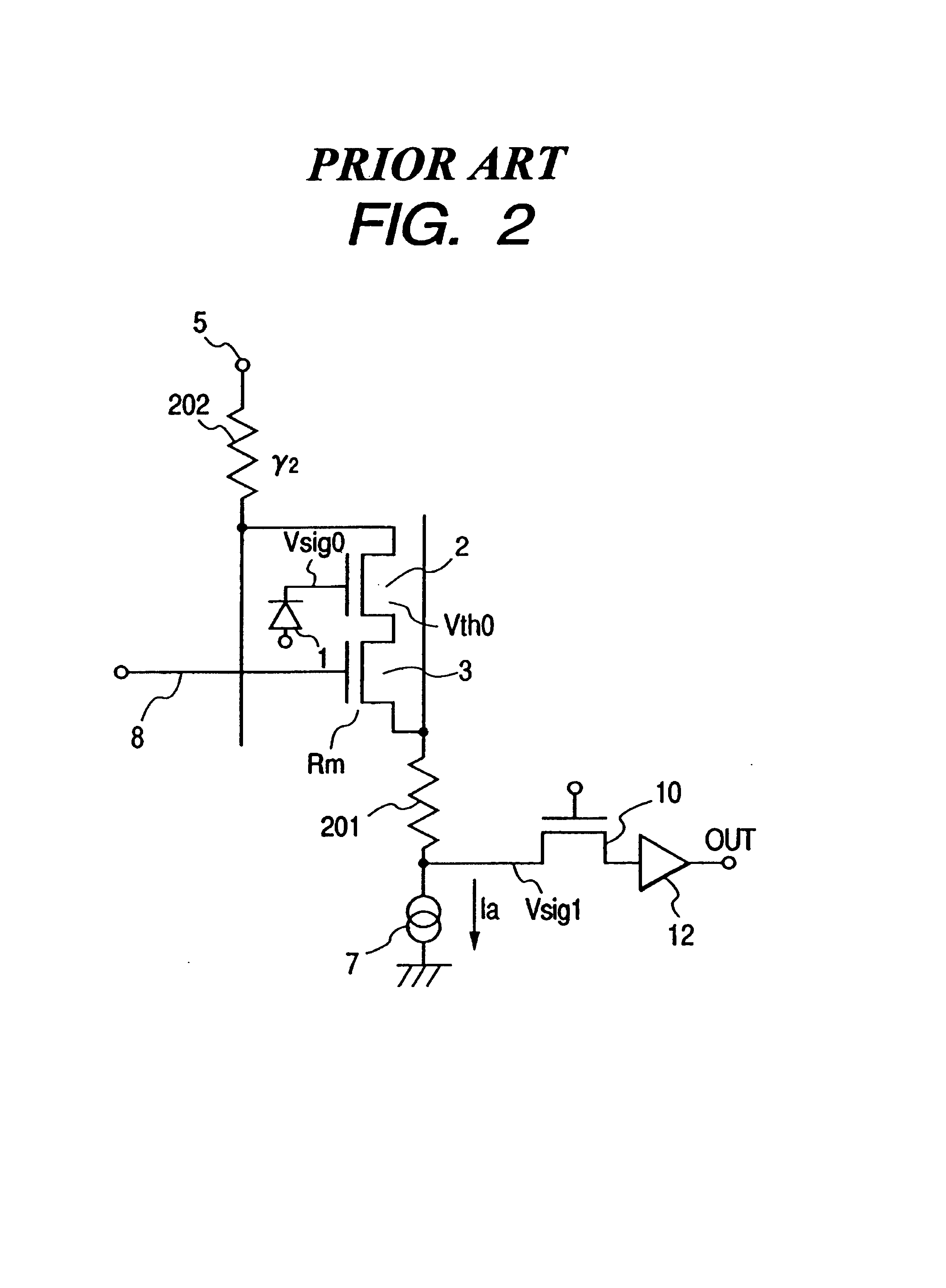Photoelectric conversion apparatus which avoids certain shading effects
a conversion apparatus and photoelectric technology, applied in the field of photoelectric conversion apparatus, can solve the problems of deteriorating image quality, affecting the quality of photoelectric conversion, and affecting the quality of photoelectric conversion, and achieve the effect of high-quality photoelectric conversion
- Summary
- Abstract
- Description
- Claims
- Application Information
AI Technical Summary
Benefits of technology
Problems solved by technology
Method used
Image
Examples
first embodiment
[0029]FIG. 3 is a diagram for explaining the present invention. Constant current sources 7 are located on the side vertically opposite to the direction of outputting signal voltages from a source follower circuit. Referring to FIG. 3, photoelectric conversion elements (e.g., photodiodes) 1 store charges in accordance with the amounts of incident light and form a two-dimensional array (4×4 elements in FIG. 3). One terminal of the photoelectric conversion element 1 is connected to the gate of a source follower input MOS 2. The source of the source follower input MOS 2 is connected to the drain of a vertical selection switch MOS 3. The drain of the source follower input MOS 2 is connected to a power supply terminal 5 through a power supply line 4. The source of the vertical selection switch MOS 3 is connected to a load power supply 7 through a vertical output line 6. The source follower input MOS 2, the vertical selection switch MOS 3, and load power supply 7 form a source follower cir...
second embodiment
[0042]FIG. 5 is a chart for explaining the present invention. Constant current sources are located on vertically the same side as a direction of outputting signal voltages from source follower circuits, and at the same time, the signal voltages in units of rows are alternately output in opposite directions.
[0043]Referring to FIG. 5, photoelectric conversion elements (e.g., photodiodes) 1 store charges in accordance with the amounts of incident light and form a two-dimensional array (4×4 elements in FIG. 5). One terminal of the photoelectric conversion element 1 is connected to the gate of a source follower input MOS 2. The source of the source follower input MOS 2 is connected to the drain of a vertical selection switch MOS 3. The drain of the source follower input MOS 2 is connected to a power supply terminal 5 through a power supply line 4. The source of the vertical selection switch MOS 3 is connected to a load power supply 7 through a vertical output line 6. The source follower ...
third embodiment
[0056]FIG. 6 is a diagram for explaining the present invention. The power supply terminals of source follower circuits are alternately arranged at vertically opposite positions.
[0057]Referring to FIG. 6, photoelectric conversion elements (e.g., photodiodes) 1 store charges in accordance with the amounts of incident light and form a two-dimensional array (4×4 elements in FIG. 6). One terminal of the photoelectric conversion element 1 is connected to the gate of a source follower input MOS 2. The source of the source follower input MOS 2 is connected to the drain of a vertical selection switch MOS 3. The drain of the source follower input MOS 2 is connected to a power supply terminal 5 through a power supply line 4. The source of the vertical selection switch MOS 3 is connected to a load power supply 7 through a vertical output line 6. The source follower input MOS 2, the vertical selection switch MOS 3, and load power supply 7 form a source follower circuit. The photoelectric convers...
PUM
 Login to View More
Login to View More Abstract
Description
Claims
Application Information
 Login to View More
Login to View More - R&D
- Intellectual Property
- Life Sciences
- Materials
- Tech Scout
- Unparalleled Data Quality
- Higher Quality Content
- 60% Fewer Hallucinations
Browse by: Latest US Patents, China's latest patents, Technical Efficacy Thesaurus, Application Domain, Technology Topic, Popular Technical Reports.
© 2025 PatSnap. All rights reserved.Legal|Privacy policy|Modern Slavery Act Transparency Statement|Sitemap|About US| Contact US: help@patsnap.com



